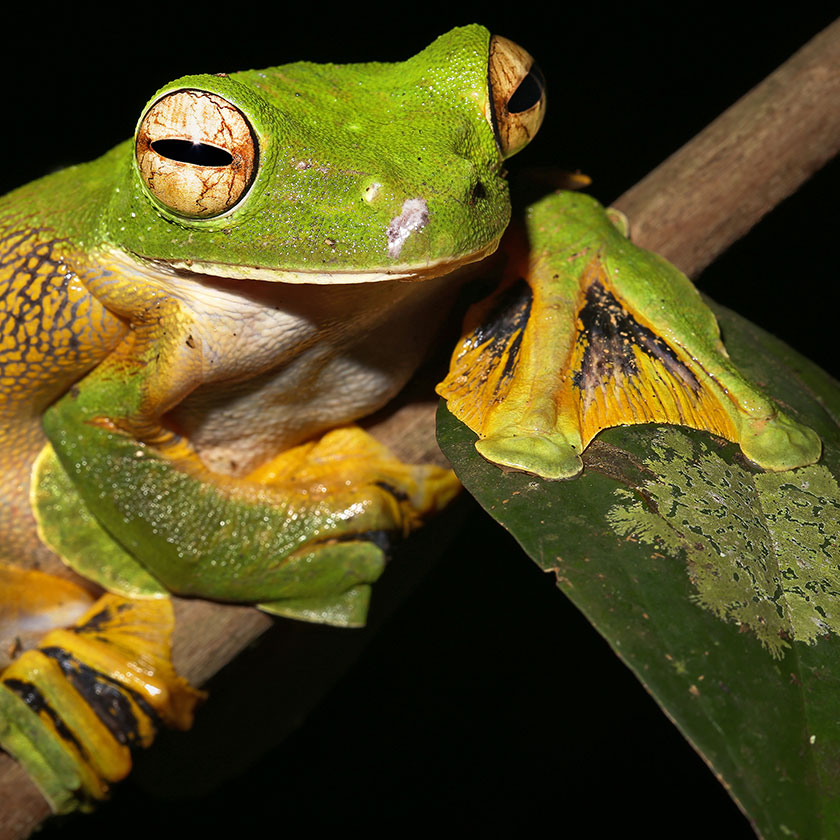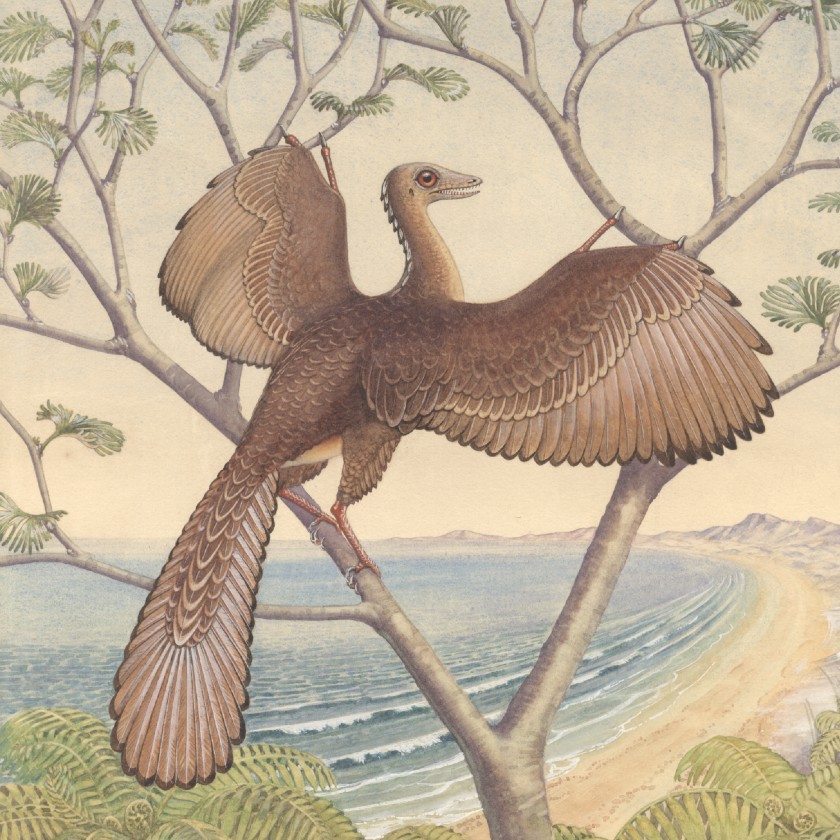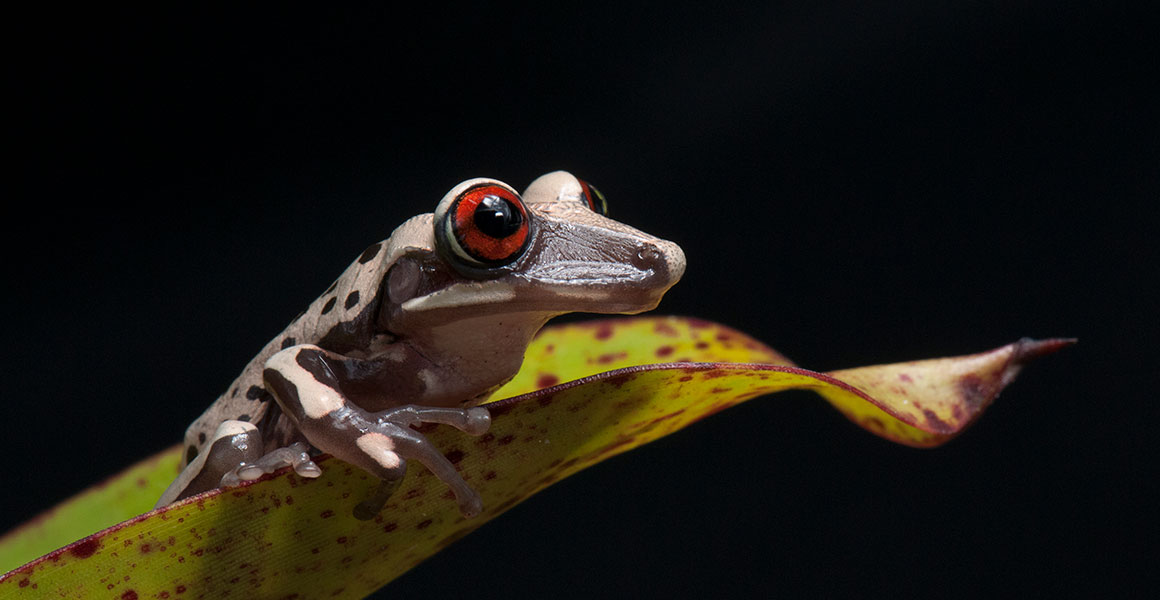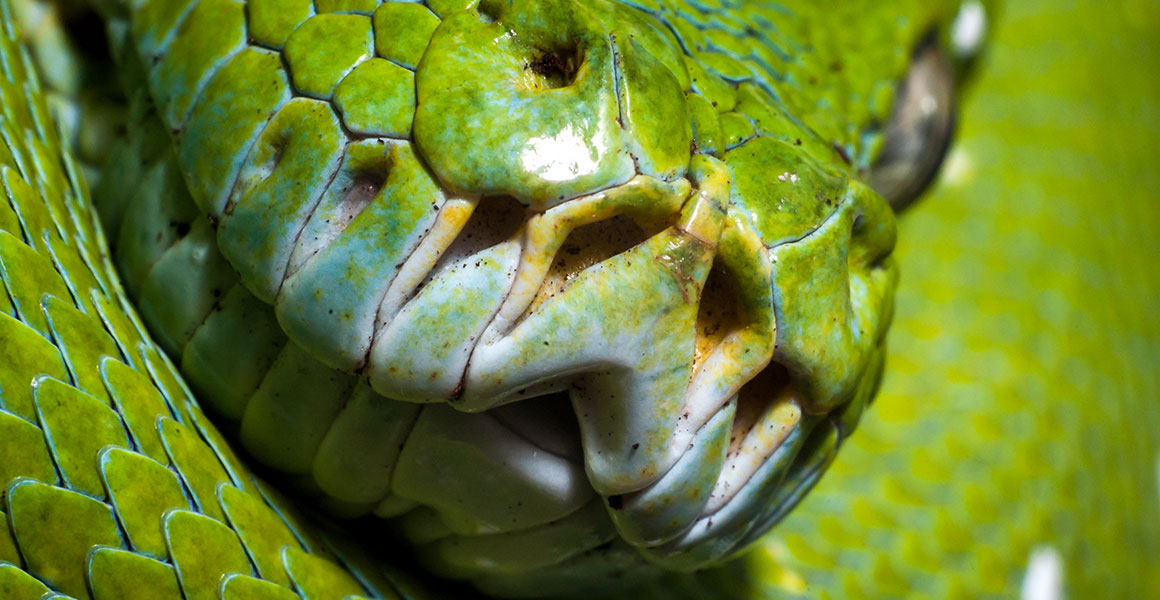
Paradise tree snake, Chrysopelea paradisi.
© reptiles4all via Shutterstock
Fantastic flyers: 10 animals that fly in surprising ways
Jay Sullivan
The air isn’t just for insects, bats or birds – there are a few other animals that can take to the skies. From tree snakes to flying fish, discover some creatures that use the air to their advantage.
%20sbs-portrait.jpg)
Image © Yuttana Joe via Shutterstock
1. Colugos
Colugos – animals in the family Cynocephalidae – can glide for 100 metres or more between trees, making them among the most skilled gliding mammals. They’re found in southeast Asia and are sometimes referred to as the flying lemur.
Their membrane, the patagium, is like that of the flying squirrel except it starts at its face and covers its fingers and toe tips through to the tail.
The colugo’s limbs and tail are long and slender, and its feet are broad and have strong, sharp recurved claws for climbing. Its lightweight skeleton and wide surface area of the patagium perfectly equip it for gliding.
Colugos have large eyes that give them brilliant depth perception, which helps them to glide between trees and land safely. They’re such skilled gliders that they can transport their babies on to their stomachs until they are old enough to glide on their own.
Colugos eat saps, leaves and shoots. They have comb-shaped teeth, which some scientists believe may act as food strainers or scrapers, or maybe used for grooming to remove parasites from their fur. Habitat fragmentation, hunting and deforestation are threatening their numbers.
%20sbs-portrait.jpg)
Image © reptiles4all via Shutterstock
2. Paradise tree snake
The paradise tree snake, Chrysopelea paradisi, can glide by flattening and stiffening its body while held in an S-shape. It can even make slight turns in the air by moving its body, and they undulate to maintain stability. By tilting their bodies 25 to 30 degrees against the airflow it stays aerodynamic and can travel more than 20 metres.
Paradise tree snakes feed on geckos and other lizards, bats, and frogs. They live in southeast Asia and reach lengths of up to 1.5 metres. They’re diurnal and are easy to identify due to their bright colouring and red flower-like scales.

Image © Valt Ahyppo via Shutterstock
3. Kuhl’s parachute gecko
Kuhl’s parachute gecko, Gekko kuhli, also known as the common flying gecko is an Asian lizard found in southern Thailand, Myanmar, Malaysia, Indonesia and Singapore.
These geckos have flaps on either side of their body, plus webbed feet and a flat tail that helps them to glide over short distances. The flaps on their sides also blends with tree bark, camouflage so effective that only their eyes can be seen.
Like flying frogs, it can grip onto even smooth and vertical or overhanging surfaces.
%20sbs-landscape.jpg)
Image © Pavaphon Supanantananont via Shutterstock
4. Freshwater butterfly fish
The freshwater butterfly fish, Pantodon buchholzi, takes its name from the shape of its fins.
Found in Africa, this predatory fish will wait in pools of slow-moving water for prey to pass by, using sensors in their skin to detect the small waves caused by insects landing on the surface. They then use their pectoral fins to propel themselves to the surface and capture the insects. They can detect prey with pinpoint accuracy.
Freshwater butterfly fish can also jump out of the water for a short time by gliding to the surface to avoid predators. They can use their swim bladders to breathe surface air and remain buoyant for short amounts of time.
These fish have both air and water vision. Their eyes are directed upwards to watch for insects, scan the water, and look for predators all at once.
%20sbs-landscape.jpg)
Image © Moushomi via Shutterstock
5. Flying squirrel
When you think of flying animals, it’s likely that birds and bats come to mind before flying squirrels – animals in the tribe Pteromyini. There are 50 different species and are all characterised by their aerial abilities.
Flying squirrels don’t really fly – instead they are able to glide thanks to the membrane between their front and back legs that acts like a parachute. The squirrels travel from tree to tree by jumping from a high branch, stretching their limbs to reveal the gliding membrane. Some species can glid for up to about 46 metres.
The earliest fossil skeleton of flying squirrel dates back to 11 million years ago and is very similar to the large flying squirrel species that currently inhabit the tropical and subtropical forests of Asia. Most species are usually nocturnal and some species have a specialised diet, but generally they are omnivorous and eat fruit, seeds, insects, and birds’ eggs.
%20sbs-landscape.jpg)
Image © Lisa Strachan via Shutterstock
6. Flying fish
Flying fish – species in the family Exocoetidae – live in warm ocean waters around the world. There are 70 known species of flying fish. They’re shaped like a torpedo, which streamlines their bodies and lets them build up speed underwater so that they can break to the surface.
This and their large tails allow them to build up speed as they approach the surface. Once the fish has broken the surface its elongatated lower tail lobe can still beat in the water, providing further thrust. At the right moment, large wing-like pectorals – which were held close to the body when the fish was submerged – are extended. The fish gains lift and becomes airborne.
Some flying fish also have large pelvic fins and are known as four-winged flying fish. These fish can reach speeds of 60 kilometres per hour before taking flight, which they do by beating their tails whilst still below the surface. This method causes them to reach heights of 1.2 metres and glide for around 200 metres.
Once it nears the surface again, the fish can beat the lower lobe of its tail as it re-enters the water. Flying fish have been recorded stretching out their flights with consecutive glides spanning up to 400 metres. Scientists believe that flying fish evolved to glide so that they could escape predators. Flying fish live on a diet of plankton, and are hunted by mackerel, tuna, swordfish, and marlin amongst other large fish.
%20sbs-portrait.jpg)
Image © dokosola via Shutterstock
7. Japanese flying squid
The Japanese flying squid, Todarodes pacificus, also known as the Japanese common squid, is native to the north Pacific Ocean, specifically around Korea, Japan, China, Russia and the Bering Strait. The female is larger than the male, growing up to 50 centimetres long. Like many other cephalopods they can change colour to match their environment, helping to camouflage them from predators.
The Japanese flying squid uses jet propulsion to speed through the water. It does this by taking water into its mantle – the muscular cavity that protects the squid's body – and pushing it out through the siphon – a tube-like structure used to expel water, waste and ink.
This jet propulsion is so powerful that Japanese flying squid are able to propel themselves out of the water and glide by spreading out their fins and arms creating aerodynamic lift. Once in the air, they can travel up to 11 metres per second. It’s believed they use this gliding ability to escape predators but also to travel quickly – they can move five times faster through air than water. Japanese flying squid use their quick speed to catch the fish and crustaceans that make up their diet.
%20sbs-portrait.jpg)
Image © Corina Sturm via Shutterstock
8. Draco lizard
The small draco lizard, Draco volans, relies on its gliding ability to escape predators, find food and even attract a mate. They live in the jungles of southeast Asia and mostly eat ants and termites.
It has elongated ribs which extend and retract as needed, and between the ribs is a fold of skin which acts as wings when unfolded. Draco lizards use their tails to steer and can travel distances of up to 58 metres. They can turn their wrists 90 degrees to grab their ‘wings’ while in flight.
Draco lizards grow to just 20 centimetres, including their tails. The underside of their wings is blue in males and yellow in females, while their dewlap – the skin at the base of their neck – is yellow in males and blue-grey in females. Males are very territorial and will use their gliding skills to chase other lizards from the trees they see as their own.

Image © Ryan M. Bolton via Shutterstock
9. Wallace’s flying frog
Also known as parachute frogs, Wallace’s flying frogs, Rhacophorus nigropalmatus, live in the thick rainforests of Malaysia and Indonesia. They spend most of their lives in trees, descending only to find a mate and lay eggs.
They use their webbed feet to glide between trees or to the ground and can travel up to 15 metres this way. This ability helps them to catch prey, which is mostly insects, and escape predators if necessary. They have large toe pads which enable a soft landing and help them stick to tree trunks.
There are other frogs that can glide, but Wallace’s flying frogs are some of the largest. They’re identifiable by their black foot webbing, bright green bodies and yellow sides. They grow up to 10 centimetres long.
The Wallace’s flying frog population is stable, though as they often lay eggs on leaves above the wallowing holes of the nearly extinct Asian rhinoceros, further decreases in the rhino population may impact the success of the frog’s tadpoles.

Image © The Trustees of the Natural History Museum
10. Ambopteryx
Over 160 million years ago in the Late Jurassic Period, the tiny Ambopteryx longibrachium would have been seen gliding from tree to tree. Living in what’s now China, this omnivore used leathery bat-like wings to get around.
Discovered in 2017, Ambopteryx is the second dinosaur to be found with large membranes on its wings, hence its Latin name that means ‘both wings’. From fossils, palaeontologists can tell that its stomach contained gizzard stones like modern plant-eating birds, but also bone fragments. An adult weighed just a few hundred grams.
This dinosaur belongs to the scansoriopterygid family, which also includes Yi qi, another bat-winged dinosaur. The fossil of Yi qi was found with traces of a brown film on one wing, thought to be traces of a wing membrane. This discovery shows that non-bird dinosaurs were experimenting with different ways of flying, including bat-like wings and wings closer to those of birds. Researchers now think at least four different dinosaurs learned to fly, including scansoriopterygids.




Don't miss a thing
Receive email updates about our news, science, exhibitions, events, products, services and fundraising activities. We may occasionally include third-party content from our corporate partners and other museums. We will not share your personal details with these third parties. You must be over the age of 13. Privacy notice.
Follow us on social media